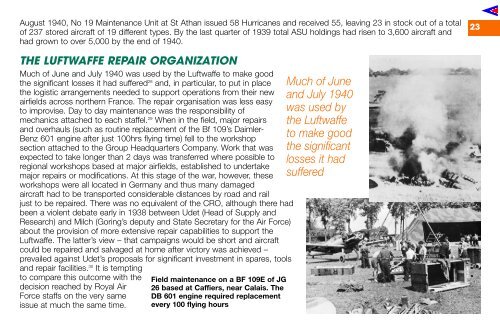THE ROYAL AIR FORCE - Air Power Studies
THE ROYAL AIR FORCE - Air Power Studies
THE ROYAL AIR FORCE - Air Power Studies
Create successful ePaper yourself
Turn your PDF publications into a flip-book with our unique Google optimized e-Paper software.
August 1940, No 19 Maintenance Unit at St Athan issued 58 Hurricanes and received 55, leaving 23 in stock out of a total<br />
of 237 stored aircraft of 19 different types. By the last quarter of 1939 total ASU holdings had risen to 3,600 aircraft and<br />
had grown to over 5,000 by the end of 1940.<br />
<strong>THE</strong> LUFTWAFFE REP<strong>AIR</strong> ORGANIZATION<br />
Much of June and July 1940 was used by the Luftwaffe to make good<br />
the significant losses it had suffered 28 and, in particular, to put in place<br />
the logistic arrangements needed to support operations from their new<br />
airfields across northern France. The repair organisation was less easy<br />
to improvise. Day to day maintenance was the responsibility of<br />
mechanics attached to each staffel. 29 When in the field, major repairs<br />
and overhauls (such as routine replacement of the Bf 109’s Daimler-<br />
Benz 601 engine after just 100hrs flying time) fell to the workshop<br />
section attached to the Group Headquarters Company. Work that was<br />
expected to take longer than 2 days was transferred where possible to<br />
regional workshops based at major airfields, established to undertake<br />
major repairs or modifications. At this stage of the war, however, these<br />
workshops were all located in Germany and thus many damaged<br />
aircraft had to be transported considerable distances by road and rail<br />
just to be repaired. There was no equivalent of the CRO, although there had<br />
been a violent debate early in 1938 between Udet (Head of Supply and<br />
Research) and Milch (Goring’s deputy and State Secretary for the <strong>Air</strong> Force)<br />
about the provision of more extensive repair capabilities to support the<br />
Luftwaffe. The latter’s view – that campaigns would be short and aircraft<br />
could be repaired and salvaged at home after victory was achieved –<br />
prevailed against Udet’s proposals for significant investment in spares, tools<br />
and repair facilities. 30 It is tempting<br />
to compare this outcome with the<br />
decision reached by Royal <strong>Air</strong><br />
Force staffs on the very same<br />
issue at much the same time.<br />
Field maintenance on a BF 109E of JG<br />
26 based at Caffiers, near Calais. The<br />
DB 601 engine required replacement<br />
every 100 flying hours<br />
Much of June<br />
and July 1940<br />
was used by<br />
the Luftwaffe<br />
to make good<br />
the significant<br />
losses it had<br />
suffered<br />
23

















